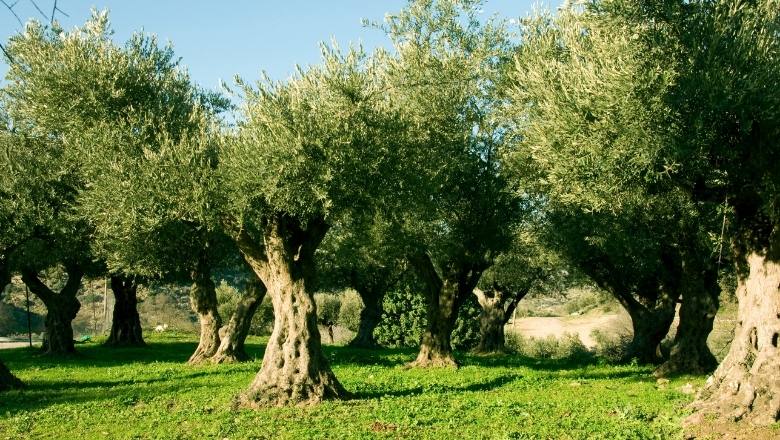Can Olive Trees Grow Anywhere?
Olive Knowledge is a part of Amazon Associates. As an Amazon Associate, we earn from qualifying purchases. Read our Affiliate Disclosure to learn more.
Some trees can grow literally anywhere, but what’s the situation like with olives? Let’s find out.
Key Takeaways:
- Olive trees can’t grow everywhere.
- They thrive in subtropical climates with plenty of sunshine and prefer warmer climates.
- Olive trees need at least 6 hours of sunlight daily and 2100 hours annually.
- Ideal temperatures for olive growth are 26-32°C (80-90°F) in summer and above -3°C (28°F) in winter.
- They favor slightly sloped terrains for better sunlight and air circulation.
- Olive trees grow in well-draining soils with a balanced air and water ratio and a pH of around 6.5.
- In the USA, you can grow olive trees in USDA 8-11 zones.
Olive Tree Weather and Environment Requirements

There are some weather and environmental requirements that should be met in order to grow olives healthily, in which they’ll bear plenty of fruits every year.
Once you know what type of weather and soil requirements olive have, you’ll immediately know whether they’ll be suitable for your area or not. So, make sure to read them below thoroughly.
Weather Requirements
Olive trees love subtropical climates, especially Mediterranean-like climates with hot summers and warmer winters. These plants are extremely drought tolerant, but they’re not so forgiving when it comes to freezing, especially if the soil is moist.
For healthy growth, olive trees require at least 6 hours of sunlight every day. In terms of a year, they need at least 2100 hours of sun every year.
The ideal temperatures during the summer are from 26 to 32 degrees Celsius (80 to 90 Fahrenheit). Since olive trees are tolerant to hot weather, they’ll easily tolerate even higher temperatures if they’re adequately watered.
They’ll grow in areas that usually don’t go below -3 degrees Celsius (28 Fahrenheit) during the winter. However, they’ll tolerate even colder weather up to -12 Celsius (10 Fahrenheit), but trees will probably die if it lasts for more than 5-7 days.
When it comes to water requirements, olive trees need a minimum of 80-100 liters of rain per square meter every month (20-25 liters of rain per week). Luckily, this can easily be fixed by regularly watering olive trees.
Another thing olive trees like is airflow. They’ll grow better and healthier in areas with plenty of airflow. Of course, they don’t like strong winds, but the light breeze is good for them because it brings fresh air all the time. They don’t like closed valley areas.
Terrain Requirements
Positions with air currents are suitable for raising olive groves because those that consist of valleys retain cold air and are not acceptable, and flat positions are not entirely suitable for the choice of raising an intensive olive grove, except in some cases.
Olives prefer positions with a slight slope, up to 15%. A slight slope will allow them to acquire more sunlight and fresh air during the day.
South and south-west positions are ideal for olive growth. That, paired with a slight slope, will potentiate healthy olive growth, and they’ll produce many fruits.
Soil Requirements
Olive trees aren’t as picky as some other plants when it comes to soil requirements. They can grow in poor soils, too, but don’t expect them to bear many fruits in those kinds of soils.
Olive trees prefer well-draining soil types where the soil isn’t highly moist throughout the year. Again, sandy types of soil that drain all the water aren’t suitable either. Optimal soil for olives is one in which the ratio of air and water is in balance.
Olives prefer soils where the pH is about 6.5. Limestone soils with neutral and slightly acid reactions, like terra rosa, are ideal for growing olives.
Olive trees don’t need extremely fertile soil to grow when it comes to soil fertility. However, the more fertile the soil, the better the olives will grow and bear more fruit.
Also, olive trees prefer soils that are rich in calcium. Luckily, this can also be fixed by using a calcification–calcium enrichment method. You can always check that data by doing a soil analysis.
Can You Force Olive Trees To Grow in Unsuitable Areas?

No doubt, you can’t force olive trees to grow literally anywhere. However, sometimes it’s possible to influence a few factors to make olives grow in your area.
Factors that you can’t affect are:
- Temperature (unless you grow olives indoors)
- Number of sunny days
- Relief
So, if these two factors aren’t suitable for growing olive trees, you’ll never be able to grow olive trees, at least not the ones that produce fruit and stay healthy for many years.
Factors that you can adapt (sometimes):
- Soil – The soil can sometimes be adapted to be suitable for growing olives. For instance, if the soil lacks calcium, you can do a calcification method. Another example is soils that don’t drain water well enough; some procedures can be done to remove the excess water from the soil, but they’re usually costly.
- Wind – If you live in a highly windy area, installing windbreaks will protect the olives from that wind and prevent potential damage. This method is also extremely expensive and isn’t worth it unless you plan to grow thousands of olive trees.
- Water requirements – if there aren’t enough rain in your area, you can fix that by regularly watering olive trees. If the rains are sporadic, watering olive trees can cost a fortune.
As you can see from the examples above, it can be very costly to fix some of these things. In my opinion, it is better to accept that your area is not suitable for growing olives than to spend a lot of money to adapt it.
However, if you want to grow one or two olive trees just for design purposes, adapting some things might not be that expensive. For anything else (oil production, etc.), I wouldn’t do any major procedures in order to adjust the area for olives.
People who want to grow olive trees just for design purposes often opt for dwarf olive trees, which are cheaper to maintain, and they never grow too big for a pot. The most important thing is that creating an artificial microclimate for them is much easier, so that you can adapt to the climate and make the trees able to grow.
Where Can Olive Trees Grow In The USA?
In the USA, the olive trees mostly grow in plant hardiness zones between 8 to 11. Some varieties can grow in zone 7, too, but some things may need to be adjusted.
The easiest way you can check whether you live in a suitable zone is by going to the USDA Plant Hardiness Zone Map and checking your area’s zone.
The USA states suitable for growing olives are:
- California
- Texas
- Georgia (southern part)
- Florida
- Louisiana
- Oregon (western part)
- Arizona (southern part)
- Alabama (southern part)
- Mississippi (southern part)
- Hawaii
Similar Articles For You:
